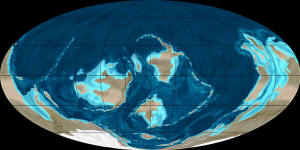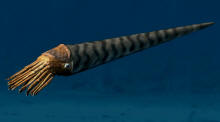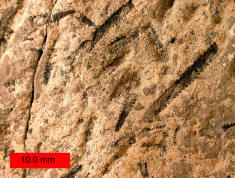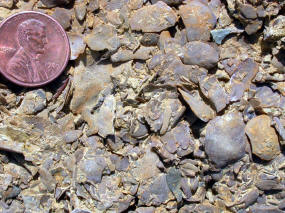The boundary chosen for the beginning both of the Ordovician period and the Tremadocian stage is highly useful. Since it correlates well with the occurrence of widespread graptolite, conodont, and trilobite species, the base of the Tremadocian allows scientists not only to relate these species to each other, but to species that occur with them in other areas as well. This makes it easier to place many more species in time relative to the beginning of the Ordovician Period.
Paleogeography and Atmosphere
Sea levels were high during the Ordovician; in fact during the Tremadocian, marine transgressions worldwide were the greatest for which evidence is preserved in the rocks.
|
Paleogeography during the Middle Ordovician Period, about 470 Ma (Picture Source) |
During the Ordovician, the southern continents were collected into a single continent called Gondwana. Gondwana started the period in equatorial latitudes and, as the period progressed, drifted toward the South Pole. Early in the Ordovician, the continents Laurentia (present-day North America), Siberia, and Baltica (present-day northern Europe) were still independent continents (since the break-up of the supercontinent Pannotia earlier), but Baltica began to move towards Laurentia later in the period, causing the Iapetus Ocean to shrink between them. The small continent Avalonia separated from Gondwana and began to head north towards Baltica and Laurentia. The Rheic Ocean between Gondwana and Avalonia was formed as a result.
A major mountain-building episode was the Taconic orogeny that was well under way in Cambrian times. In the beginning of the Late Ordovician, from 460 to 450 Ma, volcanoes along the margin of the Iapetus Ocean spewed massive amounts of carbon dioxide into the atmosphere, turning the planet into a hothouse. These volcanic island arcs eventually collided with proto North America to form the Appalachian mountains. By the end of the Late Ordovician these volcanic emissions had stopped. Gondwana had by that time neared or approached the pole and was largely glaciated.
The Ordovician was a time of calcite sea geochemistry in which low-magnesium calcite was the primary inorganic marine precipitate of calcium carbonate. Carbonate hardgrounds were thus very common, along with calcitic ooids, calcitic cements, and invertebrate faunas with dominantly calcitic skeletons.
Climate
The Early Ordovician climate was thought to be quite warm, at least in the tropics. As with North America and Europe, Gondwana was largely covered with shallow seas during the Ordovician. Shallow clear waters over continental shelves encouraged the growth of organisms that deposit calcium carbonates in their shells and hard parts. The Panthalassic Ocean covered much of the northern hemisphere, and other minor oceans included Proto-Tethys, Paleo-Tethys, Khanty Ocean which was closed off by the Late Ordovician, Iapetus Ocean, and the new Rheic Ocean.
As the Ordovician progressed, we see evidence of glaciers on the land we now know as Africa and South America. At the time these land masses were sitting at the South Pole, and covered by ice caps.
Life
|
Large Nautiloids like
Orthoceras were among the largest predatory animals in the
Ordovician. (Picture
Source) |
|
Graptolites (Amplexograptus) from the Ordovician near Caney Springs, Tennessee. (Picture Source) |
For most of the Late Ordovician, life continued to flourish, but at and near the end of the period there were mass-extinction events that seriously affected planktonic forms like conodonts, graptolites, and some groups of trilobites (Agnostida and Ptychopariida, which completely died out, and the Asaphida which were much reduced). Brachiopods, bryozoans and echinoderms were also heavily affected, and the endocerid cephalopods died out completely, except for possible rare Silurian forms. The Ordovician-Silurian Extinction Events may have been caused by an ice age that occurred at the end of the Ordovician period as the end of the Late Ordovician was one of the coldest times in the last 600 million years of earth history.
Fauna
Though less famous than the Cambrian explosion, the Ordovician featured an adaptive radiation, the Ordovician radiation, that was no less remarkable; marine faunal genera increased fourfold, resulting in 12% of all known Phanerozoic marine fauna. The trilobite, inarticulate brachiopod, archaeocyathid, and eocrinoid faunas of the Cambrian were succeeded by those which would dominate for the rest of the Paleozoic, such as articulate brachiopods, cephalopods, and crinoids; articulate brachiopods, in particular, largely replaced trilobites in shelf communities. Their success epitomizes the greatly increased diversity of carbonate shell-secreting organisms in the Ordovician compared to the Cambrian.
|
Brachiopods and bryozoans in an Ordovician limestone, southern Minnesota. (Click for larger view. From Wikipedia) |
In North America and Europe, the Ordovician was a time of shallow continental seas rich in life. Trilobites and brachiopods in particular were rich and diverse. The first Bryozoa appeared in the early Ordovician as did the first coral reefs, although solitary corals date back to at least the Cambrian.
Molluscs, which had appeared during the Cambrian or even the Ediacaran, became common and varied, especially bivalves, gastropods, and nautiloid cephalopods.
Now-extinct marine animals called graptolites thrived in the oceans. Some new cystoids and crinoids appeared.
It was long thought that the first true vertebrates (fish — Ostracoderms) appeared in the Ordovician, but recent discoveries in China reveal that they probably originated in the Early Cambrian. The very first gnathostome (jawed fish) appeared in the Late Ordovician epoch.
During the Middle Ordovician there was a large increase in the intensity and diversity of bioeroding organisms. This is known as the Ordovician Bioerosion Revolution. It is marked by a sudden abundance of hard substrate trace fossils such as Trypanites, Palaeosabella and Petroxestes.
In the Early Ordovician, trilobites were joined by many new types of organisms, including tabulate corals, strophomenid, rhynchonellid, and many new orthid brachiopods, bryozoans, planktonic graptolites and conodonts, and many types of molluscs and echinoderms, including the ophiuroids ("brittle stars") and the first sea stars. Nevertheless the trilobites remained abundant, with all the Late Cambrian orders continuing, and being joined by the new group Phacopida.
In the Middle Ordovician, the trilobite-dominated Early Ordovician communities were replaced by generally more mixed ecosystems, in which brachiopods, bryozoans, molluscs and echinoderms all flourished, tabulate corals diversified and the first rugose corals appeared; trilobites were no longer predominant. The planktonic graptolites remained diverse, with the Diplograptina making their appearance. Bioerosion became an important process, particularly in the thick calcitic skeletons of corals, bryozoans and brachiopods, and on the extensive carbonate hardgrounds which appear in abundance at this time. One of the earliest known armoured agnathan ("ostracoderm") vertebrate, Arandaspis, dates from the Middle Ordovician.
Trilobites in the Ordovician were very different than their predecessors in the Cambrian. Many trilobites developed bizarre spines and nodules to defend against predators such as primitive sharks and nautiloids while other trilobites such as Aeglina prisca evolved to become swimming forms. Some trilobites even developed shovel-like snouts for ploughing through muddy sea bottoms.
Flora
Marine fungi were abundant in the Ordovician seas to decompose animal carcasses, and other wastes.
Green algae were common in the Late Cambrian (perhaps earlier) and in the Ordovician. Terrestrial plants probably evolved from green algae, first appearing in the form of tiny non-vascular mosses resembling liverworts. Fossil spores from land plants have been identified in uppermost Ordovician sediments.
Among the first land fungi may have been arbuscular mycorrhiza fungi (Glomerales), playing a crucial role in facilitating the colonization of land by plants through mycorrhizal symbiosis, which makes mineral nutrients available to plant cells; such fossilized fungal hyphae and spores from the Ordovician of Wisconsin have been found with an age of about 460 million years ago, a time when the land flora most likely only consisted of plants similar to non-vascular bryophytes.
End of Period Extinction Events
The Ordovician came to a close in a series of extinction events that, taken together, comprise the second largest of the five major extinction events in Earth's history in terms of percentage of genera that went extinct. The only larger one was the Permian-Triassic extinction event.
The extinctions occurred approximately 447–444 million years ago and mark the boundary between the Ordovician and the following Silurian Period. At that time all complex multicellular organisms lived in the sea, and about 49% of genera of fauna disappeared forever; brachiopods and bryozoans were greatly reduced, along with many trilobite, conodont and graptolite families.
Return to the Old Earth Ministries Online Earth History Curriculum homepage.
![]()



